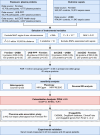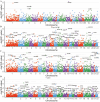Therapeutic Targets for Sepsis: Multicenter Proteome-Wide Analyses and Experimental Validation
- PMID: 40459852
- PMCID: PMC12235691
- DOI: 10.1021/acs.jproteome.5c00148
Therapeutic Targets for Sepsis: Multicenter Proteome-Wide Analyses and Experimental Validation
Abstract
Sepsis is a life-threatening condition with high mortality, underscoring the urgent need for effective therapeutic targets. We conducted a proteome-wide Mendelian randomization (MR) analysis using plasma protein data from the FinnGen, UKB-PPP, and deCODE cohorts to identify proteins causally associated with sepsis. The analysis included 16,074 cases and 363,227 controls in FinnGen and 11,643 cases and 474,841 controls in the UK Biobank, spanning four exposure-outcome combinations. Proteins were prioritized based on a false discovery rate <0.05 in one combination and p < 0.05 in another. Colocalization and phenome-wide association studies (PheWAS) were performed to evaluate causality and potential off-target effects. Three proteins─dual specificity phosphatase 13 (DUSP13), inhibin beta C chain (INHBC), and toll-like receptor 1 (TLR1)─showed strong evidence of colocalization with sepsis risk. PheWAS confirmed broader disease associations for DUSP13 and TLR1, while INHBC showed no significant adverse associations and is considered druggable. TLR1 is currently under clinical investigation. ELISA-based experimental validation in 20 sepsis patients and 20 controls demonstrated elevated serum levels of DUSP13 and INHBC and reduced levels of TLR1 in sepsis. These findings identify DUSP13, INHBC, and TLR1 as promising therapeutic targets for sepsis, supported by genetic, phenotypic, and experimental evidence.
Keywords: PheWAS; colocalization analysis; druggability; proteome-wide Mendelian randomization; sepsis; therapeutic targets.
Figures





Similar articles
-
Therapeutic targets for Alzheimer's disease: Proteome-wide Mendelian randomization and colocalization analyses.J Alzheimers Dis. 2025 Jul;106(2):695-702. doi: 10.1177/13872877251344572. Epub 2025 Jul 1. J Alzheimers Dis. 2025. PMID: 40452368
-
Causal Effects of the Plasma Proteome on Vascular Dementia Risk: A Mendelian Randomization Study with Experimental Validation.Cell Mol Neurobiol. 2025 Jul 7;45(1):66. doi: 10.1007/s10571-025-01583-9. Cell Mol Neurobiol. 2025. PMID: 40622612 Free PMC article.
-
Systematic Druggable-Proteome-Wide Mendelian Randomization Identifies Potential Therapeutic Targets for Allergic Conjunctivitis.Transl Vis Sci Technol. 2025 Jul 1;14(7):6. doi: 10.1167/tvst.14.7.6. Transl Vis Sci Technol. 2025. PMID: 40622200 Free PMC article.
-
Automated monitoring compared to standard care for the early detection of sepsis in critically ill patients.Cochrane Database Syst Rev. 2018 Jun 25;6(6):CD012404. doi: 10.1002/14651858.CD012404.pub2. Cochrane Database Syst Rev. 2018. PMID: 29938790 Free PMC article.
-
Drugs for preventing postoperative nausea and vomiting in adults after general anaesthesia: a network meta-analysis.Cochrane Database Syst Rev. 2020 Oct 19;10(10):CD012859. doi: 10.1002/14651858.CD012859.pub2. Cochrane Database Syst Rev. 2020. PMID: 33075160 Free PMC article.
References
-
- World Health Organization. Sepsis, 2023. https://www.who.int/news-room/fact-sheets/detail/sepsis.
Publication types
MeSH terms
Substances
LinkOut - more resources
Full Text Sources
Medical

